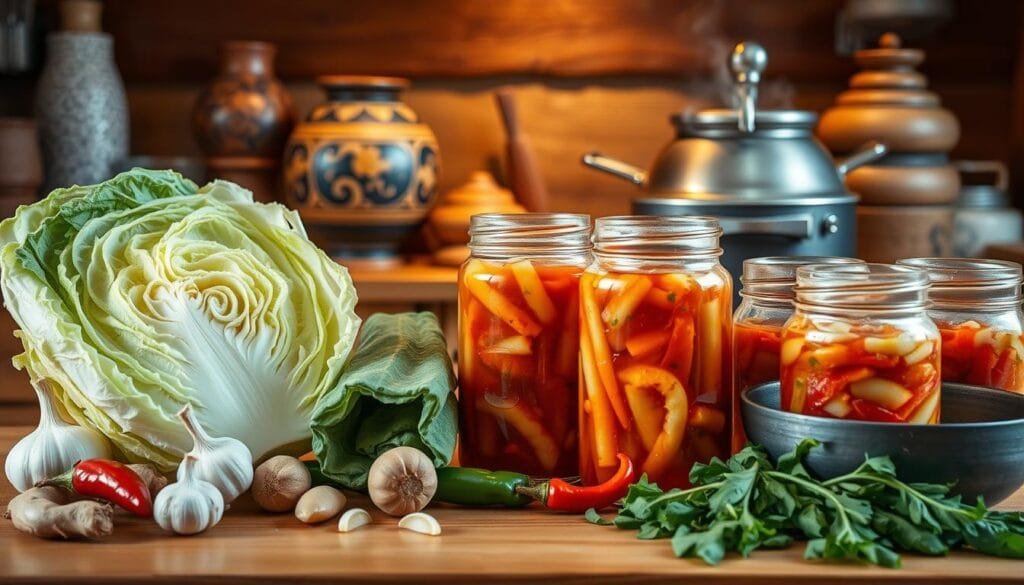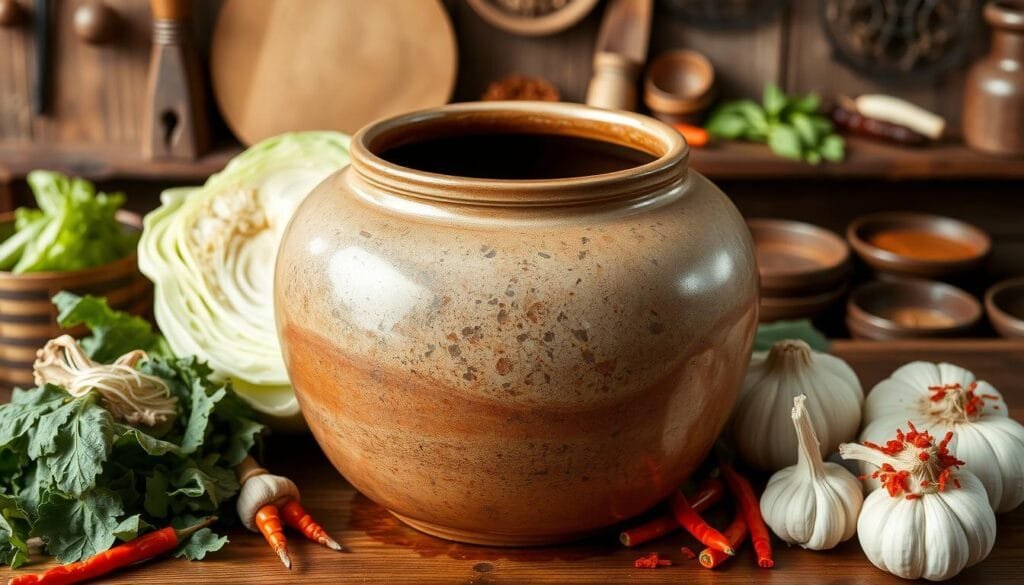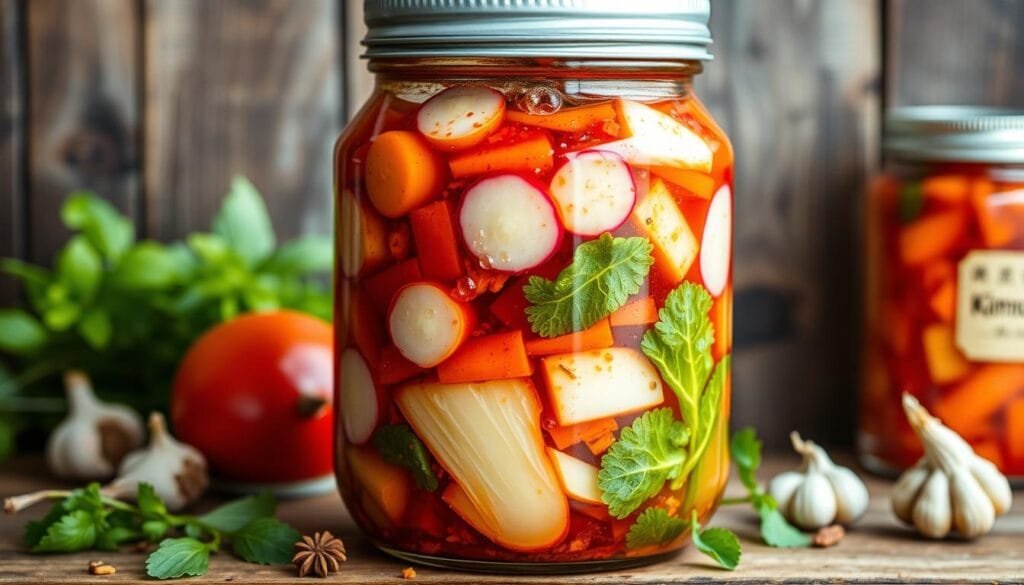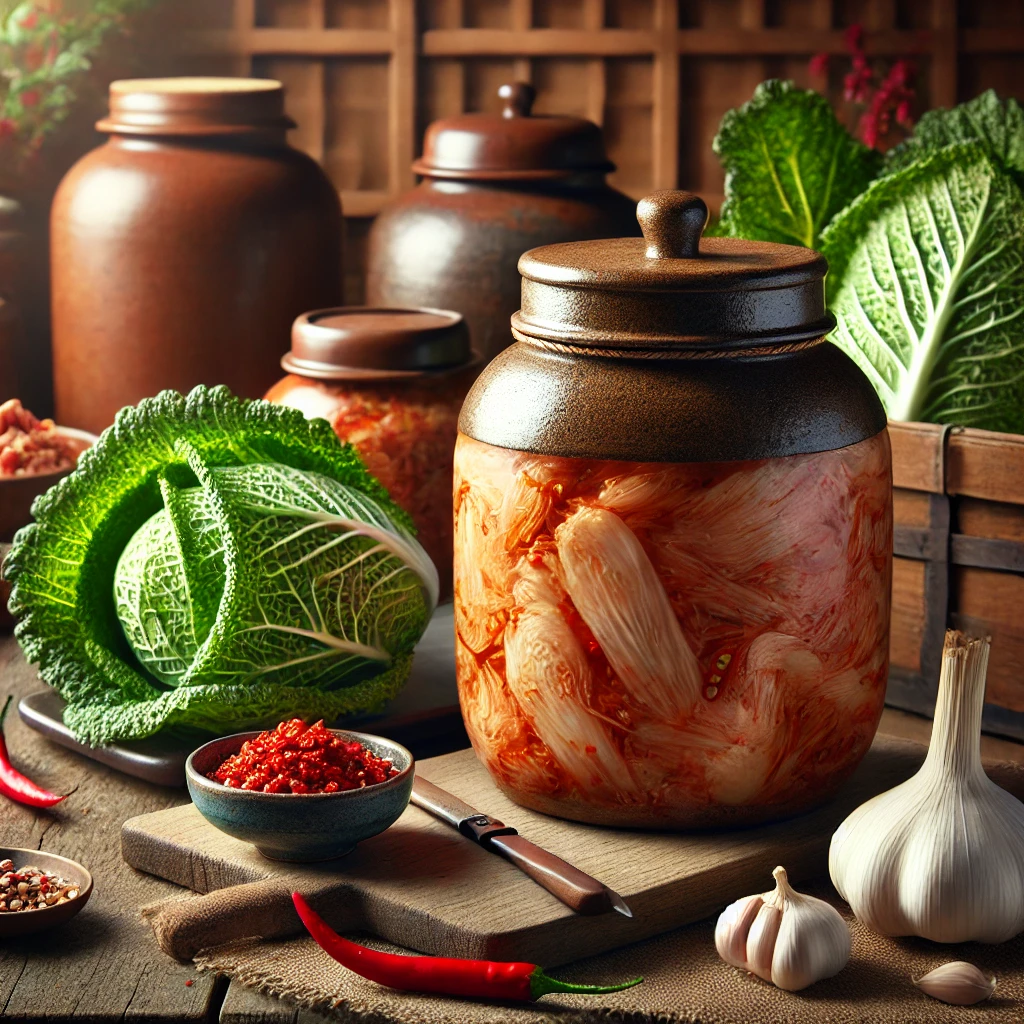10 Quick and Easy Steps to Becoming a Kimchi Fermentation Pro
In Seoul, a small family-owned restaurant was famous for its kimchi. Mrs. Choi, the owner, had spent years mastering fermentation. She taught her children her secrets. An American tourist found this place and fell in love with the kimchi’s flavors and history.
This chance meeting sparked a passion in the tourist. They went home eager to learn kimchi fermentation. They found it wasn’t hard with the right help. Anyone can become a kimchi expert quickly.
This article will show you how to make delicious kimchi at home. It doesn’t matter if you’re a food lover or a beginner. You’ll learn to make bold, tangy kimchi. Your friends and family will be impressed by your cooking skills.

Table of Contents
Key Takeaways
- Discover the fundamental ingredients and techniques for traditional Korean kimchi fermentation
- Understand the science behind the fermentation process and its cultural significance
- Learn how to select the perfect vegetables and seasoning components for authentic kimchi fermentation
- Master the art of proper container selection, salt ratio, and brine preparation
- Explore the differences between fresh and fermented kimchi fermentation, and master the optimal temperature and time control
- Uncover pro tips for storing and enjoying your homemade fermented kimchi hot sauce
- Become a confident fresh kimchi vs fermented enthusiast and start creating your own signature kimchi blends
Understanding the Basics of Traditional Korean Kimchi Fermentation
Kimchi is more than a tasty side dish. It’s a centuries-old tradition in Korean culture. The fermentation process preserves flavors and offers health benefits.
Essential Ingredients for Authentic Kimchi
The key to authentic Korean mark’s fermented kimchi hot sauce is choosing the right ingredients. The main parts usually include:
- Napa cabbage or Korean radish
- Chili peppers or gochugaru (Korean red pepper flakes)
- Garlic, ginger, and scallions
- Salts and fish-based seasonings like salted shrimp or anchovy sauce
The Science Behind Fermentation Process
The magic of turning fresh veggies into mark’s fermented kimchi hot sauce is fascinating. Beneficial bacteria like Lactobacillus grow during fermentation. They turn the veggies’ sugars into lactic acid, giving kimchi its tangy taste.
Cultural Significance and Health Benefits
Kimchi is more than a dish in Korean cuisine; it’s a cultural symbol. It’s a tradition passed down through generations. It’s also packed with health benefits, thanks to the fermentation process.

Selecting the Right Vegetables and Seasoning Components
Creating the perfect fresh kimchi vs fermented starts with picking the right vegetables and seasonings. Authentic Korean fermented kimchi hot sauce needs a mix of crisp, tasty veggies and aromatic spices. This mix creates a unique and exciting taste.
Napa cabbage is a top pick for kimchi because it’s sturdy and can hold lots of flavor. But, people are now trying different veggies like radish, scallions, carrots, and even Korean pear or persimmon.
- Napa cabbage: A classic choice, offering a sturdy texture and bold flavor profile.
- Radish: Adds a refreshing crunch and peppery notes to the kimchi.
- Scallions: Contribute aromatic layers and a touch of sweetness.
- Carrots: Bring vibrant color and a subtly sweet undertone.
- Korean pear or persimmon: Introduce unique and unexpected flavors to the mix.
The seasonings are just as crucial. Traditional Korean kimchi uses ginger, garlic, fish sauce, and Korean red pepper flakes (gochugaru). These ingredients make the kimchi rich and umami. Modern recipes might add soy sauce, sugar, or fruit juices to balance the flavors.
“The key to exceptional kimchi lies in the quality and freshness of the ingredients. Seek out the best produce and seasonings to unlock the true depth of flavor.”
Choosing the right veggies and seasonings is key to making great fresh kimchi vs fermented. It lets you explore the world of traditional Korean flavors with a modern twist.

Choosing the Perfect Kimchi Fermentation Container
Fermenting kimchi at home needs the right container. The container keeps flavors and textures right. It also helps with fermentation conditions.
Glass vs. Ceramic Fermentation Jars
For kimchi fermentation containers, glass and ceramic jars are top choices. Each has its own benefits:
- Glass jars don’t react with food, perfect for fermentation.
- Ceramic jars keep a steady temperature, key for kimchi fermentation.
Size and Storage Considerations
Think about size and storage when picking a kimchi fermentation container. Big containers are for large batches. Small jars are better for families. Make sure there’s room for the kimchi to grow.
Proper Sealing Techniques
Sealing the container right is key for kimchi fermentation. Use an airlock or weight to keep the kimchi under brine. Check the seal often to keep fermentation going well.
| Material | Advantages | Considerations |
|---|---|---|
| Glass | Non-reactive, easy to clean | May break if dropped |
| Ceramic | Maintains consistent temperature | Heavier and more fragile |
“Choosing the right kimchi fermentation container is crucial for ensuring the perfect texture, flavor, and consistency of your homemade kimchi.”
Mastering the Salt Ratio and Brine Preparation
Getting the right amount of salt in your kimchi is key to its taste and preservation. The salt ratio affects both the flavor and the fermentation process. This ensures your fermented kimchi hot sauce turns out great.
Here are some tips for the salt ratio and brine:
- Use 2-3% salt by weight of the vegetables. This helps lactic acid bacteria grow, making your fresh kimchi vs fermented product tasty and preserved.
- Make the brine by dissolving salt in water. Aim for a salinity of 5-8% to match your taste and the vegetables.
- Make sure the vegetables are fully covered in brine. This stops air from getting in and causing mold or bad bacteria.
Mastering salt ratio and brine makes your where to buy fermented kimchi taste like traditional Korean food.
| Salt Concentration | Fermentation Time | Flavor Profile |
|---|---|---|
| 2-3% salt by weight | 4-7 days | Mild, slightly sour |
| 3-5% salt by weight | 7-14 days | Moderately sour, complex |
| 5-8% salt by weight | 14-21 days | Intensely sour, pungent |
“The perfect kimchi is a harmonious balance of flavors, achieved through the careful control of salt and the fermentation process.”
Fresh Kimchi vs. Fermented: Temperature and Time Control
Making delicious kimchi requires finding the right balance between fresh and fermented. The fermentation process is key to unlocking the flavors and health benefits of this Korean dish. Knowing the differences between fresh and fermented kimchi helps home cooks get the perfect taste and texture.
Indoor vs. Outdoor Fermentation Methods
The place where you ferment kimchi affects the final taste. Fermenting indoors, in a cool, dark spot, results in a milder flavor. Outdoor fermentation, with its changing temperatures, can make the kimchi taste more intense and pungent.
Monitoring Fermentation Progress
- Watch the fermentation closely, checking the kimchi for color, texture, and smell changes.
- Try the kimchi often to see if it’s sour enough, adjusting the time as needed.
- Use a hydrometer or pH meter to check the brine’s gravity and acidity, making sure it’s fermenting right.
Signs of Successful Fermentation
- The kimchi should taste sour and slightly fizzy, with a crunchy texture.
- The brine should be clear, showing a balanced fermentation.
- The kimchi should look vibrant and colorful, without any mold or discoloration.
By controlling temperature and time, home cooks can make fresh kimchi that’s crunchy or fermented kimchi with rich flavors. Learning to ferment kimchi is rewarding, letting you tailor the taste to your liking.
Conclusion: Storing and Enjoying Your Homemade Kimchi
Now that you’ve learned how to make traditional Korean kimchi, it’s time to learn how to store and enjoy it. Keeping your kimchi in airtight containers, like a kimchi fermentation jar, is important. This helps keep the flavor and texture right.
Use your homemade kimchi in many dishes, from Korean classics to new recipes. Add it to stir-fries, rice bowls, or as a topping for mark’s fermented kimchi hot sauce. The bold, tangy flavors of kimchi can spice up any meal.
If you run into problems while making kimchi, go back to the tips in this article. Fix any issues and try new vegetable mixes or seasonings. Making your own kimchi lets you create a unique flavor that’s all yours.
FAQ
What is the difference between fresh kimchi and fermented kimchi?
Fresh kimchi is made by mixing ingredients and eating it right away. Fermented kimchi, on the other hand, is made by letting it sit for a while. This lets the flavors grow stronger.
Fermented kimchi tastes more complex, tangy, and acidic than fresh kimchi.
Where can I buy fermented kimchi?
You can find fermented kimchi at Asian grocery stores, specialty food shops, or online. Look for brands like Mark’s Fermented Kimchi Hot Sauce.
Should kimchi be fermented outside?
Kimchi can ferment indoors or outdoors, depending on the weather. Outdoor fermentation is traditional but harder to control. Indoor fermentation, in a special container, keeps the temperature and humidity steady.
What is the best container for fermenting kimchi?
The best container is a glass or ceramic jar with a tight lid. These materials don’t react with the kimchi and let air in. Choose a size that fits the kimchi, leaving room for brine and gases.
How do I achieve the perfect salt ratio for kimchi fermentation?
The perfect salt ratio is 2-3% of the vegetable’s total weight. This helps draw out moisture and create the right brine. It’s key to measure the salt carefully and adjust for your ingredients and taste.
Spicy Korean Recipe 2024.
- Rise and Shine with a Spicy Kimchi Breakfast Bowl
- Kickstart Your Morning with a Kimchi Spicy Frittata
- Barley & Kimchi Pancakes: Crispy, Savory, & Totally Irresistible!
- Quick Kimchi Pears: Sweet, Spicy, & Tangy
Cooking is an act of love and creativity! 🌟 What do you think of this recipe? I’d love to hear your thoughts and any tips or tweaks you’d suggest to make it even better. Let’s inspire each other in the kitchen!
There are no reviews yet. Be the first one to write one.








